What is a Pushchair single buggy with buggy board?
A single pushchair is designed to carry one child (although some can be used as early as birth with an infant car seat or carrycot). Some are lightweight and can be converted into a double.
It is a popular choice for families due to its sleek, modern design and features, including height-adjustable handles and a large shopping basket. It also comes with machine-washable fabrics as well as a footmuff, essential for winter weather.
Convertible
Convertible strollers are an excellent option for parents who need a stroller that will grow with their child. This type of stroller has hammock seats that can transform into a carrycot, and it’s an ideal option for babies. It’s also lightweight and easy to fold.
A first-of-its-kind one-of-a-kind Larktale crossover is a stroller/wagon that quickly transforms into a double-seater, with no tools required. It is equipped with numerous features that make it a great option for parents, like the large undercarriage as well as an organizer hanging by the push bar in both modes. There are some drawbacks like the nebulous zipper that connects the back of seat 1 in wagon mode as well as the size of the cup holders.
Brakes
 A good pushchair single will come with several braking systems. One is the hand brake which is typically an incredibly small lever located on the rear of the chassis that you flick down to stop the vehicle and then push it up to begin the process again. This is helpful in urban terrain, where you may need to slow down quickly, or on pavements at shopping centres where pedestrians might be present. The front wheel brake system can be present on high-end pushchairs, such as the phil&teds Dash and Bugaboo Cameleon 3. It is activated the same way as the brake on a bicycle. This is particularly helpful when you’re running or walking over rough terrain, as it will stop the pushchair right away and keep your child safe.
A good pushchair single will come with several braking systems. One is the hand brake which is typically an incredibly small lever located on the rear of the chassis that you flick down to stop the vehicle and then push it up to begin the process again. This is helpful in urban terrain, where you may need to slow down quickly, or on pavements at shopping centres where pedestrians might be present. The front wheel brake system can be present on high-end pushchairs, such as the phil&teds Dash and Bugaboo Cameleon 3. It is activated the same way as the brake on a bicycle. This is particularly helpful when you’re running or walking over rough terrain, as it will stop the pushchair right away and keep your child safe.
The left coupling 171 for the rear legs 57 and 19 consists of a rod for mounting the rear leg 173 to which the rear leg 57 is fixedly to a gear that is mounted on the side of 163 within the hub 3 of housing 33; a securing bushing 177 to gear 175 that extends out of a slot at the end of mounting bar 173 and a cable that is designed to wrap around J-shaped spool 181 as well as the post 31 of the front leg 19. The left coupling system 171 for the rear leg 57 and the front leg 19 includes a rear leg mounting bar 173 to which the rear 57 is fixedly coupled; a gear 175 positioned on the side surface 163 of the housing 33 disposed within hub 3; spool component 181 and the post 31 of the front leg 19 are wrapped around the J-shaped spool part 181 in the slot 179 provided at the end of the mounting bar 173 and a coiled cable 183.
The brake system 215 is comprised of a first end, 227. It is configured to contact brake cams in the second position. It also has a second end, 229. The second end of the brake lever has a variety of teeth 231. The teeth are arranged to be able to engage the teeth 232 of a gear 233 driven by a first rear wheel 59 of stroller 1. When the brake lever is pressed the braking cylinder stops the wheel from rotating on the first rearwheel 59 of stroller 1. The braking system is operated by hand.
Seat unit/carrycot
A single pushchair is a travel system for infants specifically designed for babies over 6 months old who are starting to sit up. They often have the option of converting into a pram. Prams typically include more sophisticated features and are usually designed for infants and toddlers, and have extra padding to keep your child comfortable.
Many pushchairs work with car seats and allow you to make a travel package that lets you move sleeping babies from your car to the pushchair. Some come with an infant carrycot, which is ideal for babies, while some come with a seat unit that is able to be used when your baby is ready to transition from the carrycot.
 The majority of ‘from birth’ pushchairs offer the option of facing directions for the seat unit/carrycot, either facing the parent to reassure and bond with baby or world facing so that they can explore the world. Some pushchairs permit you to connect an additional carrycot infant carrier or ride-onboard.
The majority of ‘from birth’ pushchairs offer the option of facing directions for the seat unit/carrycot, either facing the parent to reassure and bond with baby or world facing so that they can explore the world. Some pushchairs permit you to connect an additional carrycot infant carrier or ride-onboard.
A quality pushchair must be able to move smoothly over various terrains, such as pavements, grass, and rough surfaces. A sturdy chassis and quality tyres are crucial. Some tyres are pneumatic which require air to be added from time to time, whereas other tyres are made of an alternative material such as EVA or PU, which can provide a more comfortable and stable ride.
Your pushchair will be one of the most frequently used baby items you own so it’s worthwhile to invest in a high-quality design that’s easy to clean and maintain. A quick wipe down using a baby wipe should eliminate any spills or crumbs, while more stubborn marks can be removed by directing the hot air from your hair dryer at the area affected for a minute.


